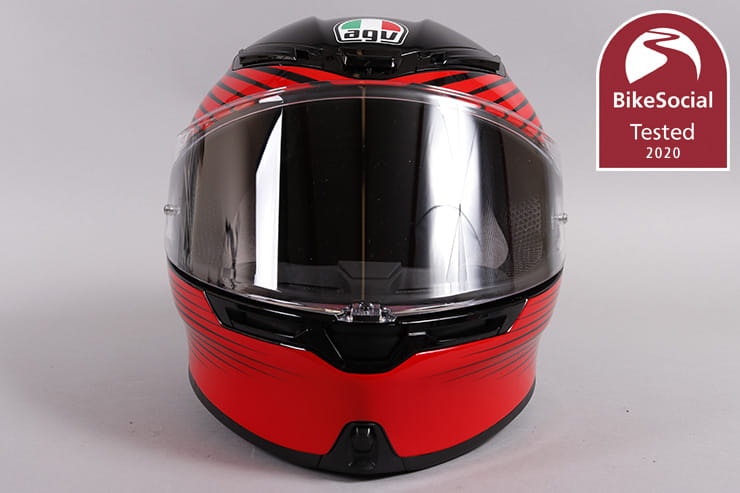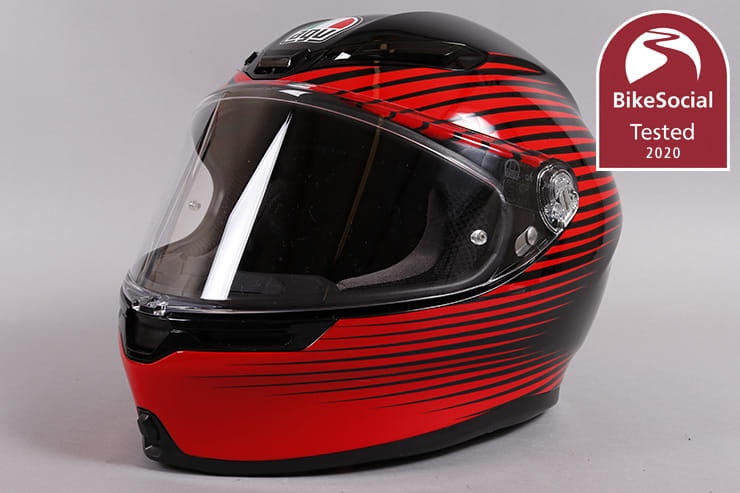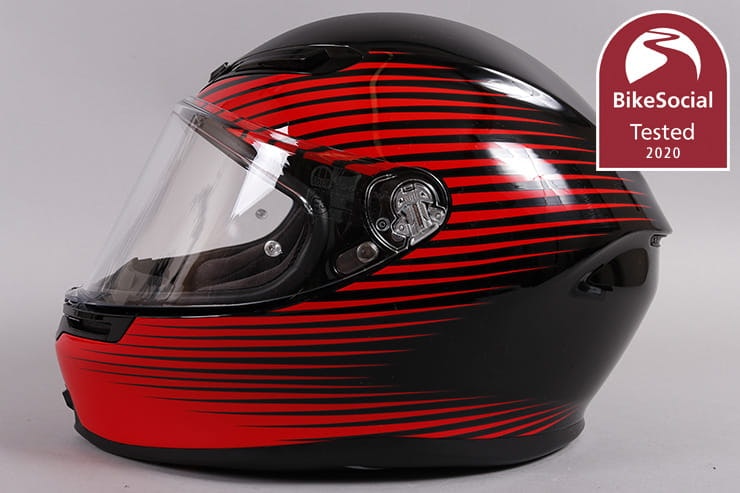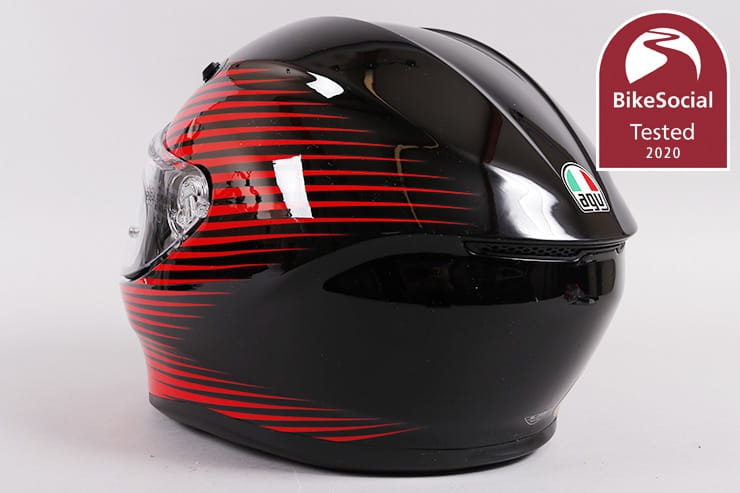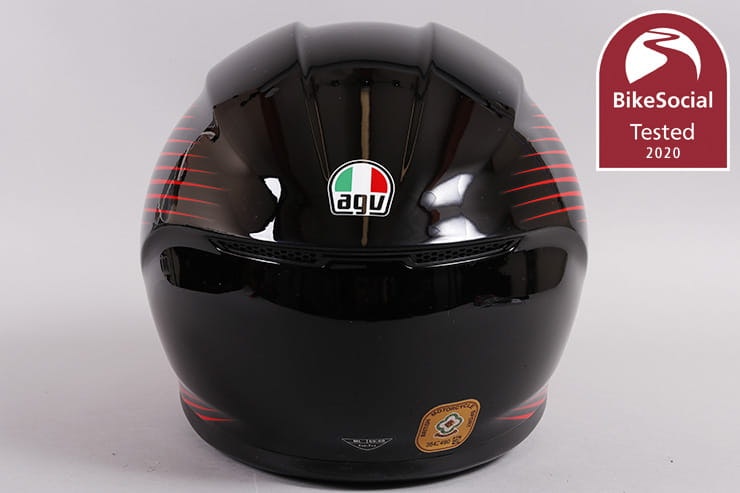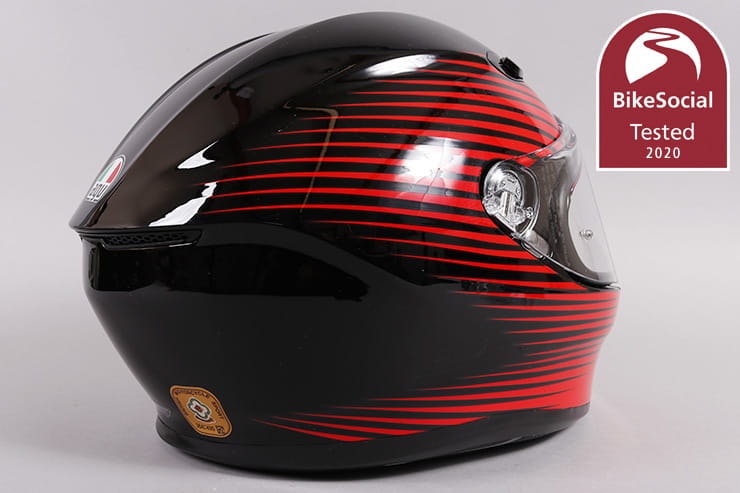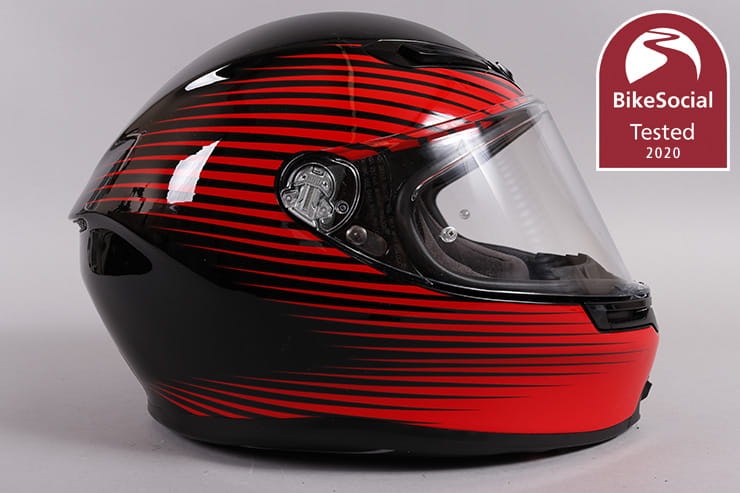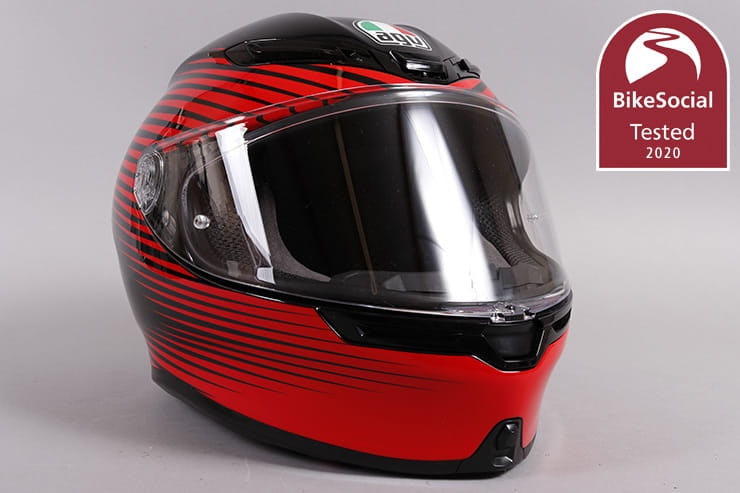Tested: AGV K6 motorcycle helmet review
By BikeSocial Member
Everyday riders, just like you...
17.07.2020
Date reviewed: July 2020 | Tested by: Bike Social Member | Price: £359.99 (solid colours), £399.99 (graphics)| www.agv.co.uk
Bennetts Rewards Member and key worker Patricia Stiemke has the AGV K6 motorcycle helmet on review for Bennetts BikeSocial. Riding every day in it, this is her honest opinion…
“It’s not one of our most popular options,” said a salesman in my local motorcycle accessories shop recently. “People don’t seem to go for AGV.”
My instant reaction was one of puzzlement; I’ve been using the AGV K6 for the past three months and I can honestly say that it’s the best helmet I have had so far. Its comfort and noise reduction are on par with more expensive lids and it doesn’t weigh a tonne either.
It’s been used constantly on my commutes at all hours and in all weathers to the tune of 3,500 miles on a CBR500R.
Very comfortable and plush upholstery
Quiet
Excellent Pinlock and visor quality
It lets in that annoying continuous drizzle type of rain through the top vents
The upper air vents are fiddly and need some force to operate
Not for you if you’re after funky patterns or colour schemes
Outer shell
The AGV K6 outer shell is a carbon-aramid-fiberglass composite with a five-density expanded polystyrene (EPS) liner, along with a ‘Collarbone Safe profile’, a feature developed by AGV to take pressure off the collarbone in the event of a collision. There’s little additional information on how exactly this profile is helpful, but I would expect AGV has supporting documentation for this claim tucked away in one of its R&D safes.
The K6 comes in six sizes, from XS to XL, with four different shell sizes ensuring those with small heads don’t have to put up with oversized helmets.
The vents and sliders are unobtrusive, and the soft feel trim around the base is good quality without gaps or splits. There’s a channel cut over the top of the head which, according to AGV, improves the aerodynamics of the helmet regardless of your riding position. As my positions vary from straight upright to chin on the tank, I can safely say that, apart from the noise quality, the air pressure and vibrations on the helmet don’t change between the different positions.
When I’m tucked away behind my windscreen it is absolute bliss.
The sides of the AGV K6 feature a sharply defined curvature inward to the bottom of the helmet. Due to the nature of this contouring, attaching a communications device becomes a bit awkward as there’s no flat surface near the neckline; the surface is actually concave. I had to place my Sena SMH-5 quite high up but, apart from the cables being a bit stretched, it is still firmly attached.
This design feature ensures a close-fitting seal around the sides and back of the neck, so I do understand why the designers have done this. Also, AGV has its own ARK communication system, which the helmet is set up for. That will set you back another £223 though.
The shell has an easy to clean, glossy finish with the pin-end red stripes of my lid inspiring the model name Rush. If you opt for solid colours in the K6 models, the price comes down by about £40.
Personally, I don’t find any of the patterns or colours very inspiring, but it’s obviously a matter of personal taste – my ultimate design is something with teeth and eyes that glow in the dark in obscenely fluorescent colours so I may not be the most sensible judge of décor. [I live more minimal designs, and in fact, the AGV K6 Minimal is – I think – an awesome look. John, Consumer Editor]
Weight
This is not the lightest helmet I have ever had. My HJC RPHA-11 is lighter but not by much and overall, I’m happy to trade in a few extra grams for all the advantages the AGV has over the HJC. <y ML size weighs in at 1440g on my kitchen scale.
Ventilation
Despite being a very close-fitting helmet in regard to the interior, the ventilation works very well indeed. The helmet sports five adjustable vents; two below the lower visor edge, on either side of the locking mechanism, two on the top on either side of the centre channel and one in the middle just above the top of the visor. Behind each vent is a large holed honeycomb plastic mesh. So far, they have not been prone to trapping insects and I’ve not found any inside the helmet.
There’s a slim extractor running across the middle tucked away under the rear spoiler, while the vents at mouth level are closed with sliding flaps operated by a small square slider at the bottom of the chin. Despite being small, it’s not hard to operate with gloves.
The two lateral top vents have sliders on rails and only have an open and closed setting as the sliders go back or forwards respectively. The sliders, despite having a small lip at the back end, are hard to get a purchase on with gloves, and are rather stiff to move. The same goes for the small vent in the centre; a small slider with a tiny lip that slides up and down. I often find that my glove slips and hits the top of the visor as the two are positioned very close to each other. I usually set my vents before I start riding because it’s a bit of an effort to adjust them while on the move.
The bottom vents have a moderate effect when open but the difference between the top vents when open and closed is very noticeable, which surprised me a bit considering their small inlets. You can feel the air rushing in, though the noise level doesn’t change significantly. It creates a good stream of air on hot days. Conversely, having the top vents closed is preferable on cold mornings.
The big problem with the top ventilation is that it lets water through even when closed; the sliders do not form a tight seal and I noticed this after riding for an hour through the dreary, non-stop, fine rain that the UK is so well known for. I had several drops running down the inside of the visor, which I can live with, but my forehead (through my balaclava) and the lining touching my brow were wet. This was a bit of a surprise because I’ve also ridden through streaming apocalyptic torrents and, apart from one or two drops invading the inner visor, the rest of the inside of the helmet was bone dry. So, there seems to be a certain type of rain that the top vents have a problem with. I can’t say that my other helmets have been 100% waterproof either, but I was not expecting it with this one.
Visor
I have almost no complaints about the visor. It’s clear, offers a wide field of vison – both horizontal and vertical – and is easy to manoeuvre, snap closed and open. Removal and replacement is a doddle and requires no tools.
The AGV K6 does not have a sun visor, though the main visor can be easily exchanged.
The visor supplied is of Optic Class 1, which has the least amount of distortion. AGV states it has a 190° horizontal field of vision (FOV). While that may be correct, for most of us mortals 120° is normal but I can also say that when panning my eyes from side to side, no bits of helmet obstruct my view.
My big bugbear is usually vertical vision as I tend to tuck in on the bike at speed; the vertical FOV is stated as 85° and that feels about right. With my head fully down about 15% of my FOV is taken up by the upper rim of the helmet, which is much better than the Nolan N87 and the HJC C70 but not quite as good as my HJC RPHA-11. I have given up looking for a helmet that offers the quiet of a touring helmet with the vertical vision of a MotoGP helmet. If they exist, they are not within my household allowance.
Visor thickness is 4 mm and the helmet comes with a Max Vision Pinlock 120, which is Pinlock’s upper quality range. It’s easy to fit and has adjusting screws to finetune the position so that all of the silicone strip is touching the visor.
The visor mechanism is made of metal, but it doesn’t feel much sturdier than a good plastic one and is quite small. Despite that, it’s not especially fiddly to take off or replace the visor. In the fully open position, you pull down on a release lever on the left and just pop it out, followed by doing the same on the right side. To install just pull on the lever again and place it into the two fitted slots and release the lever.
The visor has 4 open positions and is quite smooth to move with a lip and latch mechanism in the middle. The fourth position is the just closed setting and requires a bit more precise aim as there’s a bracket on the visor that slots into a catch. In that position the visor cannot move up unless you use the push button under the lock to release it. A further push down on the visor and it’s fully locked and closed. To open, you use the push button to release into the almost closed position and push again to fully release the visor. AGV recommends only using the just closed position at very low speeds but I certainly don’t get any vibrations or excessive particle entry at slightly higher speeds.
AGV also advertises the visor as scratch resistant but does not really explain what that means. I am the eternal klutz when it comes to banging helmets into walls, scraping the hard parts of my luggage against it, dropping the helmet at awkward angles etc. All the visors on my other helmets carry the scars of my clumsiness, but not this one. Somehow this visor has withstood my usual wear and tear and doesn’t have a mark on it, so far. I have also made a point of not cleaning it with anything except water and a soft sponge or tissues. There may be a drop of hand soap in the mix here or there, but it seems to be working. The visor is as clear as the day I got it.
I’m also getting better at fitting Pinlocks because this visor has not fogged up, at all. I have ridden in the rain with all vents closed and could only discern a tiny spot of fog, somewhere at the bottom of the visor.
My only niggle is that, during a downpour or a persistent drizzle, a few drops will make it past the substantial seal between the visor and helmet. It’s not enough to cause a problem but here I see no difference between this helmet and all the other (cheaper) helmets I’ve used.
I do have to mention the very thick, good quality silicone seal around the visor opening. AGV even supplies silicone grease for maintaining its suppleness and functionality.
Lining
The lining consists of various materials but all of them are comfortable and present no pressure points anywhere. Everything feels soft, plush and smooth against the skin and it is the first helmet that I look forward to putting on every day. I usually get problems around the ears after fitting my Sena helmet speakers because they’re quite chunky but not in this lid. Although the cut outs for speakers are no deeper than in any other helmet, the padding is much better, if not thicker than in the HJC C70, RPHA-11 or the Nolan N87.
There’s a mesh netting just under the top of the helmet followed by a soft crown pad extending to the base of the skull that creates a bit of space between the EPS and the top of your head to give some room for air to move.
The cheek pads are made of ‘Ritmo’ material, which, according to AGV, makes it easier to slide the helmet on and off. I would have to agree. This helmet slips on with ease and doesn’t tear my ears off upon removal.
There is also a removable, very flexible, soft rubber nose guard that’s unobtrusive and doesn’t pop out or distort when grabbing the helmet through the visor opening, which I do a lot.
The neck roll is a combination of that Ritmo fabric and synthetic leather. It feels soft and thick but stable and encloses the neck in a very reassuring way. It’s advertised as water and abrasion resistant and I can confirm that no wet has ever crept up from the neck roll and, for what it’s worth, I put the helmet down on the pavement a lot and it has not gained any scratches, marks or tears.
The neck roll also sports the very useful ‘cheek pad safety release system’, which allows for the quick removal of the helmet with minimal disturbance to the head in case of an accident. This is in line with the latest first aid advice of removing the helmet if the rider is not breathing, as the risk of spinal injury or skull trauma becomes a secondary concern.
The lining is removable in sections for cleaning and inspection purposes. AGV also points out that the interior has been sanitised with antimicrobial treatment. I have just one small niggle; the front of the crown pad is, like all the other sections, fastened with poppers on either side just above the forehead. If you put on the helmet a bit too vigorously, those poppers will jump out of their fasteners. The trick is to slide the helmet on until the top of the head touches the pad and then leave it be. It took me a few tries until I stopped hearing the poppers dislodge but, to be honest, they may be a just a tad too flimsy to begin with.
Fastening
The helmet uses a double D-ring retention system. The straps on this fastening slide easily through the rings and the D-rings are large and have a red grab strip of a good length. The excess of fastening strap is secured via a popper that’s on a separate piece of strap to the D-ring holders. The fastenings are well cushioned toward the skin for comfort and stability.
Unlike a ratchet mechanism, I cannot work this system with gloves on, but this fastening is once again a nice step up in comfort and quality from my previous helmets.
Fit
I can’t state often enough how comfortable this helmet is to wear. No matter how many hours I’ve had it on continuously, regardless of the weather and in spite of often being tired or frazzled from going to or returning from shift work at all hours, I’ve been very grateful to have the AGV K6 on my ride. It doesn’t create uncomfortable pressure points over time. It has not become a drag or too heavy. It just sits there and protects my head.
I do not wear glasses in traffic but have tried a few times to fit specs with the helmet and although it’s a bit of a wriggle to slide them into place, once in situ, there is no feeling of extra pressure or pinching.
Fit is obviously something personal and you have to try everything on and judge quite carefully in choosing what is undoubtedly the most important PPE for riding a motorcycle.
Not every helmet is fit for every head-shape but there is something out there for everyone.
Noise
In a word, not much. As I have already mentioned, this is the quietest helmet I’ve had; I think some of it has to do with the thick padding.
The AGV also comes with a removable wind curtain and without it, there is a sizable gap around the chin and the ride becomes more airy and noisy. Personally, I can’t really envision a situation where I wouldn’t use it unless I was on track-day with sweltering temperatures but, the option is there.
I wear ear protection, of course, and usually listen to music on my way home from work. In my other helmets the sound quality really deteriorated at high speeds, (70mph+), not so with this one. I can still hear the background instruments in both ears and not just a nonsensical beat of percussion, hinting at the track just playing. According to my better half, there’s also a lot less wind noise coming through my microphone. So, not just quiet but also sound insulating. I am very satisfied.
For more information on why earplugs are vital with any helmet, and advice on which are the best, click here.
AGV K6: Verdict
AGV has classed this lid as a sports helmet. While its range of touring helmets have different features specifically for long trips, I would have no qualms using the K6 for a grand tour, as well as on track as it has the gold ACU sticker.
The AGV K6 ticks the boxes for both comfort and functionality. The only big gripe is the entry of a certain type of rain. It is obviously disappointing, but it’s not enough to put me off; my other lids have been put back in their boxes. The K6 is in full use and will remain so. It is a good helmet for the price.
I started off my motorcycling journey with a helmet costing £126 (Caberg Stunt), moved on to test the £85 MT, then opted for the Nolan M87 at £166, before moving on to the HJC C70 at around the same price. Then I had a moment of spending madness when buying the HJC RPHA-11 at £280 (greatly reduced).
I have found that the prices were fairly representative of the quality of the helmets and this is no exception. They all do the basic job of protecting the best bit of you in a bad situation; the difference is the level of comfort, and the AGV K6 offers this at the highest level I have so far experienced.
